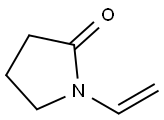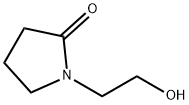N-Vinyl-2-pyrrolidone
- CAS No.
- 88-12-0
- Chemical Name:
- N-Vinyl-2-pyrrolidone
- Synonyms
- NVP;N-VINYLPYRROLIDONE;1-Vinylpyrrolidin-2-one;Vinylpyrrolidone;1-VINYL-2-PYRROLIDONE;1-VINYL-2-PYRROLIDINONE;2-Pyrrolidinone, 1-ethenyl-;N-VINYL-2-PYRROLIDINONE;N-VinyPyrrolidone;N-Vinylpyrrolidinone
- CBNumber:
- CB3272024
- Molecular Formula:
- C6H9NO
- Molecular Weight:
- 111.14
- MDL Number:
- MFCD00003197
- MOL File:
- 88-12-0.mol
- MSDS File:
- SDS
| Melting point | 13-14 °C |
|---|---|
| Boiling point | 92-95 °C11 mm Hg(lit.) |
| Density | 1.04 g/mL at 25 °C(lit.) |
| vapor density | 3.8 (vs air) |
| vapor pressure | 0.1 mm Hg ( 24 °C) |
| refractive index |
n |
| Flash point | 201 °F |
| storage temp. | Store below +30°C. |
| solubility | 52.1g/l soluble |
| form | Liquid |
| pka | -0.34±0.20(Predicted) |
| color | Clear colorless to yellow |
| PH | 9-10 (100g/l, H2O, 20℃) |
| explosive limit | 1.4-10%(V) |
| Viscosity | 2.07 cp (25C) |
| Water Solubility | miscible |
| Merck | 14,7697 |
| BRN | 110513 |
| Stability | Stable. Incompatible with strong oxidizing agents. |
| InChIKey | WHNWPMSKXPGLAX-UHFFFAOYSA-N |
| LogP | 0.4 at 25℃ |
| Indirect Additives used in Food Contact Substances | VINYLPYRROLIDONE |
| FDA 21 CFR | 175.105; 176.180 |
| CAS DataBase Reference | 88-12-0(CAS DataBase Reference) |
| EWG's Food Scores | 3 |
| FDA UNII | 76H9G81541 |
| IARC | 3 (Vol. 19, Sup 7, 71) 1999 |
| NIST Chemistry Reference | N-Vinylpyrrolidone(88-12-0) |
| EPA Substance Registry System | N-Vinyl-2-pyrrolidone (88-12-0) |
SAFETY
Risk and Safety Statements
| Symbol(GHS) |    GHS05,GHS07,GHS08 |
|||||||||
|---|---|---|---|---|---|---|---|---|---|---|
| Signal word | Danger | |||||||||
| Hazard statements | H302+H312+H332-H318-H335-H351-H373 | |||||||||
| Precautionary statements | P280-P301+P312-P302+P352+P312-P304+P340+P312-P305+P351+P338-P308+P313 | |||||||||
| Hazard Codes | Xn | |||||||||
| Risk Statements | 20/21/22-37-40-41-48/20 | |||||||||
| Safety Statements | 26-36/37/39 | |||||||||
| RIDADR | UN 2810 6.1/PG 3 | |||||||||
| WGK Germany | 1 | |||||||||
| RTECS | UY6107000 | |||||||||
| Autoignition Temperature | 685 °F | |||||||||
| TSCA | TSCA listed | |||||||||
| HazardClass | 6.1 | |||||||||
| PackingGroup | III | |||||||||
| HS Code | 29337900 | |||||||||
| Toxicity | LD50 orally in Rabbit: 1022 mg/kg | |||||||||
| NFPA 704 |
|
N-Vinyl-2-pyrrolidone price More Price(28)
| Manufacturer | Product number | Product description | CAS number | Packaging | Price | Updated | Buy |
|---|---|---|---|---|---|---|---|
| Sigma-Aldrich | V3409 | 1-Vinyl-2-pyrrolidinone contains sodium hydroxide as inhibitor, ≥99% | 88-12-0 | 1kg | $155 | 2024-03-01 | Buy |
| Sigma-Aldrich | PHR1740 | 1-Vinyl-2-pyrrolidinone Pharmaceutical Secondary Standard; Certified Reference Material | 88-12-0 | 200mg | $377 | 2024-03-01 | Buy |
| Sigma-Aldrich | 8.08518 | 1-Vinyl-2-pyrrolidone (stabilized with N,N′-di-sec-butyl-1,4-phenylenediamine) for synthesis | 88-12-0 | 5ml | $35.3 | 2024-03-01 | Buy |
| Sigma-Aldrich | 8.08518 | 1-Vinyl-2-pyrrolidone (stabilized with N,N′-di-sec-butyl-1,4-phenylenediamine) for synthesis | 88-12-0 | 250ML | $53.3 | 2024-03-01 | Buy |
| TCI Chemical | V0026 | 1-Vinyl-2-pyrrolidone (stabilized with N,N'-Di-sec-butyl-p-phenylenediamine) >99.0%(GC) | 88-12-0 | 25mL | $27 | 2024-03-01 | Buy |
N-Vinyl-2-pyrrolidone Chemical Properties,Uses,Production
Description
N-vinyl-2-pyrrolidone (NVP) is commonly used as a reactive diluent for radiation curing in UV-coating, UV-inks, and UV adhesives. It is used as a monomer to produce water soluble polyvinylpyrrolidone (PVP) with uses in pharmaceuticals, oil field, cosmetics, food additives & adhesives. It is used in the manufacture of copolymers with, for example, acrylic acid, acrylates, vinyl acetate and acrylonitrile and in the synthesis of phenolic resins.
Chemical Properties
Colorless liquid. Combustible.
Uses
A pyrrolidine used for biochemical research
Uses
1-Vinyl-2-pyrrolidinone is used in the preparation of NMDA receptor antagonists. Also used in the synthesis of copolymers used to stabilize rhodium nanoclusters.
Definition
ChEBI: N-Vinyl-2-pyrrolidone is a member of pyrrolidin-2-ones.
Application
N-Vinyl-2-pyrrolidone (NVP) is an important precursor and intermediate for process auxiliaries and additives. The main areas of use are the production of polyvinylpyrrolidone and copolymers, the preferred comonomers being vinyl acetate and methyl acrylate. Ca. 10–15% of the monomer is used in the pharmaceutical industry for the production of a polyvinylpyrrolidone–iodine complex used as a disinfectant. NVP is also used as a reactive solvent for UV-curable resins for the production of printing inks and paints as paper and textile auxiliaries, and as an additive in the cosmetics industry.
Production Methods
Industrially, N-Vinyl-2-pyrrolidone (NVP) is produced by reacting 2-pyrrolidone with acetylene in highpressure autoclaves at 130–170 ℃ and pressures of up to 2.6 MPa. Vinylation proceeds in the liquid phase and is catalyzed by 2-pyrrolidone–potassium. The salt is obtained by adding 1–5% potassium hydroxide or caustic potash solution to fresh pyrrolidone and removing excess water by vacuum distillation (batchwise or continuously). The vinylation reaction takes place in a liquid-phase tube or loop reactor, or in a gas-phase reactor. To avoid the danger of acetylene explosions, nitrogen or propane mixtures of acetylene are used instead of pure acetylene. After the vinylation, the crude product obtained is purified by multistep vacuum distillation. Unreacted 2-pyrrolidone and derivatives can be recycled. Excess acetylene is removed by distillation and can also be recycled to the process. ?Another industrially important synthetic route is based on N-(1-hydroxyethyl)-2-pyrrolidone (HEP). In this process, HEP is dehydrated in the gas phase in a heterogeneously catalyzed reaction at 320–400 ℃ and 10 kPa. The obtained crude NVP is purified by vacuum distillation or crystallization.
General Description
1-Vinyl-2-pyrrolidinone is a colorless to yellow liquid, with a characteristic odor. Its melting point is around 13.5oC and boils at about 90-92oC. VP is completely miscible in water and in most organic solvents but partially miscible in aliphatic hydrocarbons. Industrial production of VP by reacting 2-pyrrolidone with acetylene at high pressure and temperature has been reported. The vinylation process proceeds in liquid phase and is catalyzed by 3-pyrrolidone -potassium hydroxide.
Chemical Reactivity
N-Vinyl-2-pyrrolidone (NVP) is stable toward alkalis at room temperature. Above 0 ℃ it is cleaved by aqueous mineral acids into acetaldehyde and 2-pyrrolidone; the latter reacts with an excess of NVP to give 1,1'-ethylidene-bis-2- pyrrolidone. Protic compounds such as amides, thiols, alcohols, and phenols add to the double bond according to the Markovnikov rule, for example, N-(1-phenoxyethyl)-2-pyrrolidone is formed with phenol. Catalytic hydrogenation produces N-ethyl-2-pyrrolidone. Hydroformylation on rhodium catalysts forms 2-N-(2-pyrrolidonyl)-propanal as the major product. On prolonged standing, particularly in warm conditions, NVP tends to polymerize. Industrially, N-Vinyl-2-pyrrolidone (NVP) is converted into polyvinylpyrrolidone using radical initiators.
Safety Profile
Confirmed carcinogen. Moderately toxic by ingestion, inhalation, and skin contact. A severe eye irritant. Probably irritating and narcotic in high concentrations. Combustible when exposed to heat or flame; can react vigorously with oxibzing materials. To fight fire, use alcohol foam, CO2, dry chemical. When heated to decomposition it emits highly toxic fumes of NOx.
storage
N-Vinyl-2-pyrrolidone (NVP) must be protected from heat and direct sunlight. Even in closed containers NVP can only be stored for a limited period because it tends to polymerize. Stabilizers are therefore added. N,N'-Bis(1-methylpropyl)-1,4-benzenediamine [101-96-2] is an important, NVP-soluble stabilizer that does not interfere with further processing. Use of this stabilizer allows the product to be stored for ca. 300 d at 20 ℃, and ca. 150 d at 25 ℃. Stabilization with solid sodium hydroxide that can be easily filtered off is not as efficient. Storage at temperatures close to the melting point results in separation of NVP from the stabilizer due to repeated solidification and melting. This shortens the shelf life considerably and can lead to uncontrolled polymerization. Solidified NVP must therefore be molten carefully in a water bath (max. 40 ℃) or at room temperature (max. 30 ℃) and homogenized by continuous agitation.
N-Vinyl-2-pyrrolidone Preparation Products And Raw materials
Raw materials
Preparation Products
1of2
| Supplier | Tel | Country | ProdList | Advantage | |
|---|---|---|---|---|---|
| Hefei TNJ Chemical Industry Co.,Ltd. | +86-0551-65418679 +8618949832763 | info@tnjchem.com | China | 2986 | 55 |
| Tianjin Zhongxin Chemtech Co., Ltd. | +86-022-66880623 +8618622897568 | sales@tjzxchem.com | China | 563 | 58 |
| Hubei Ipure Biology Co., Ltd | +8613367258412 | ada@ipurechemical.com | China | 10319 | 58 |
| ZHEJIANG JIUZHOU CHEM CO., LTD | +86-0576225566889 +86-13454675544 | admin@jiuzhou-chem.com;jamie@jiuzhou-chem.com;alice@jiuzhou-chem.com | China | 12272 | 58 |
| Hebei Weibang Biotechnology Co., Ltd | +8615531157085 | abby@weibangbio.com | China | 8812 | 58 |
| Shaanxi Dideu Medichem Co. Ltd | +86-29-81148696 +86-15536356810 | 1022@dideu.com | China | 3882 | 58 |
| Hebei Mojin Biotechnology Co., Ltd | +86 13288715578 +8613288715578 | sales@hbmojin.com | China | 12840 | 58 |
| Shanghai UCHEM Inc. | +862156762820 +86-13564624040 | sales@myuchem.com | China | 7514 | 58 |
| Hebei Chuanghai Biotechnology Co,.LTD | +86-13131129325 | sales1@chuanghaibio.com | China | 5893 | 58 |
| Shandong Juchuang Chemical Co., LTD | +undefined15030412209 | admin@juchuangchem.com | China | 387 | 58 |
Related articles
- What are the synthesis methods of N-Vinyl-2-pyrrolidone?
- The synthesis routes of N-Vinyl-2-pyrrolidone mainly include vinylation of 2-pyrrolidone with acetylene, amination of γ-butyro....
- Mar 13,2024
- Polymerization and hydrolysis of N-Vinyl-2-pyrrolidone
- N-Vinyl-2-pyrrolidone has some special chemical properties because of the vinyl group on its nitrogen atom. The most important....
- Mar 12,2024
- Application and preparation of N-vinyl-2-pyrrolidone
- N-Vinyl-2-pyrrolidone is an organic compound with the chemical formula C6H9ON, abbreviated as NVP.
- Mar 30,2022
View Lastest Price from N-Vinyl-2-pyrrolidone manufacturers
| Image | Update time | Product | Price | Min. Order | Purity | Supply Ability | Manufacturer | |
|---|---|---|---|---|---|---|---|---|
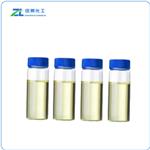 |
2024-11-22 | N-Vinyl-2-pyrrolidone NVP
88-12-0
|
US $99.00-35.00 / kg | 1kg | 99% | 20ton | Hebei Zhuanglai Chemical Trading Co.,Ltd | |
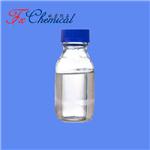 |
2024-11-21 | N-Vinyl-2-pyrrolidone
88-12-0
|
US $0.00 / KG | 200KG | 98%min | 30tons/month | WUHAN FORTUNA CHEMICAL CO., LTD | |
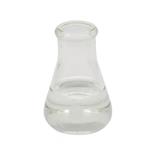 |
2024-11-11 | N-Vinyl-2-pyrrolidone
88-12-0
|
US $10.00-7.00 / kg | 1kg | 99.99% | 10 tons | Shandong Deshang Chemical Co., Ltd. |
-

- N-Vinyl-2-pyrrolidone NVP
88-12-0
- US $99.00-35.00 / kg
- 99%
- Hebei Zhuanglai Chemical Trading Co.,Ltd
-

- N-Vinyl-2-pyrrolidone
88-12-0
- US $0.00 / KG
- 98%min
- WUHAN FORTUNA CHEMICAL CO., LTD
-

- N-Vinyl-2-pyrrolidone
88-12-0
- US $10.00-7.00 / kg
- 99.99%
- Shandong Deshang Chemical Co., Ltd.





